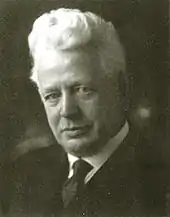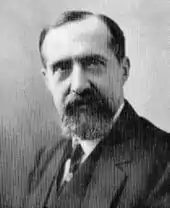Davos University Conferences
The Davos University Conferences (French: Cours universitaires de Davos; German: Davoser Hochschulkurse) were a project between 1928 and 1931 to create an international university at Davos in Switzerland.[1]
| Cours universitaires de Davos Davoser Hochschulkurse | |
| Formation | August 1927 |
|---|---|
| Dissolved | January 1933 |
| Type | Academic conferences |
| Location | |
Official language | French, German, English |
| Leader | Gottfried Salomon |
Key people | Albert Einstein, Martin Heidegger, Léon Brunschvicg, Ernst Cassirer |
Origins
The Davos University Conferences owed their creation to two complementary initiatives, one local and one international.
Local initiative

Noting the large number of tubercular students who came to Davos,[2] as a mountain town known for its cosmopolitan atmosphere and as a luxurious place to convalesce,[3] between 1926 and 1927 a committee was formed by the local doctors to formulate a diversification project for Davos University.
International initiative
The Davos project coincided with warming international relations,[4] particularly between France and the Weimar Republic (Germany) after the Locarno Pact of 1925.[5] The French intelligentsia wholeheartedly participated in projects of the International Committee on Intellectual Cooperation, but the Germans, who were excluded from it by the Treaty of Versailles, instead founded the Deutsch-französische Gesellschaft (DFG, "German-French Society").[6] German intellectuals who wanted to participate in international academic conferences approached the Davos initiators and redefined their university project to become an annual conference.[7]
Organisation
A committee made up of local and visiting academics was assembled under the chairmanship of Dr Paul Müller (instigator of the Spengler coup in 1923), the sociologist Gottfried Salomon (1892 – 1964), president of the Frankfurt DFG, and Erhard Branger (1881 – 1958), mayor of Davos, who made it their mission to invite élite European intellectuals to Davos for weeks of work and exchange of ideas. The committee was augmented in 1929 by three national committees (German, French and Swiss).
Establishment
For four consecutive years, between 1928 and 1931, the committee convened a large number of important intellectuals,[8] mainly German and French, for conferences (in both languages) lasting three weeks at the end of winter. These academics were accompanied by promising students in a programme of communautés de travail ("Work communities") and as well as the conferences themselves there were opportunities to get to know academics from other countries who were working in the same field.
Conferences
1928

The first Conference was opened by Erhard Branger (mayor of Davos), Lucien Lévy-Bruhl (French philosopher and sociologist), Hans Driesch (German philosopher) and Albert Einstein.[8]
Presenters
|
|
|
1929

The second conference was opened by Giuseppe Motta (Federal Council). It was noted for the "Cassirer–Heidegger debate" between Martin Heidegger and Ernst Cassirer.[8]
Presenters
|
|
|
Students
|
1930
The third conference was opened by Federal Councillor Heinrich Häberlin.[8] It was the first conference to be conducted partly in English.
Presenters
|
|
|
Presenters

The fourth conference was opened by Carl Heinrich Becker (lately the Prussian Minister of Culture).[8]
|
|
|
Disestablishment
The 1932 conference could not be held because of the Great Depression. Adolf Hitler's ascension and granting of absolute power on 30 January 1933, led to the exile of many German intellectuals and put an end to Franco-German co-operation in science, which made it impossible to continue the conferences.[10]
References
Notes
- Grandjean, Martin, Les cours universitaires de Davos 1928-1931. Au centre de l'Europe intellectuelle, University of Lausanne, 2011. BIB_S_000000015950
- Kollarits, Dr. (15 April 1926). "Letter". Davoser Revue. No. 7.
- Jost, Christian (1951). Der Einfluss des Fremdenverkehrs auf Wirtschaft und Bevölkerung in der Landschaft Davos (in German). Davos: Buchdrückerei Davos.
- Bock, Hans Manfred (1993). Entre Locarno et Vichy: les relations culturelles franco-allemandes dans les années 1930 (in French). Paris: CNRS éditions.
- Baechler, Christian (1996). Gustave Stresemann (1878-1929) De l’impérialisme à la sécurité collective (in French). Strasbourg: Presses Universitaires de Strasbourg.
- Bock, Hans Manfred (1990). "Francia". Die Deutsch-Französische Gesellschaft 1926 bis 1934, Ein Beitrag zur Sozialgeschichte der deutsch-französischen Beziehungen der Zwischenkriegszeit (in German). pp. 57–102.
- "Analyse de réseau" (in French). Retrieved 6 September 2012.
- Davoser Blätter [Davos Diary. 1928 – 1931]. Bern: Swiss National Library. (available only at the National Library, Ref 7q107).
- See for example Gordon, Peter Eli (2010). Continental divide : Heidegger, Cassirer, Davos. Cambridge, Massachusetts: Harvard University Press. p. 426. and Friedmann, Michael (2000). A Parting of the Ways. Carnap, Cassirer, and Heidegger. Chicago: Open Court. p. 175.
- Richard, Lionel (1987). "Aspects des relations intellectuelles et universitaires entre la France et l'Allemagne dans les années vingt". In Bariety, J.; et al. (eds.). La France et l’Allemagne entre deux guerres mondiales (in French). Nancy: Presses Universitaires de Nancy. pp. 112–124.
Further reading
- Grandjean, Martin (2011). Les cours universitaires de Davos 1928-1931. Au centre de l'Europe intellectuelle [The Davos University Conferences 1928-1931. In the Center of Intellectual Europe] (in French). Lausanne: Université de Lausanne. 139 p. (PDF)
- Grandjean, Martin (2018). Les réseaux de la coopération intellectuelle. La Société des Nations comme actrice des échanges scientifiques et culturels dans l'entre-deux-guerres [The Networks of Intellectual Cooperation. The League of Nations as an Actor of the Scientific and Cultural Exchanges in the Inter-War Period] (in French). Lausanne: Université de Lausanne. pp. 246–253 (PDF)